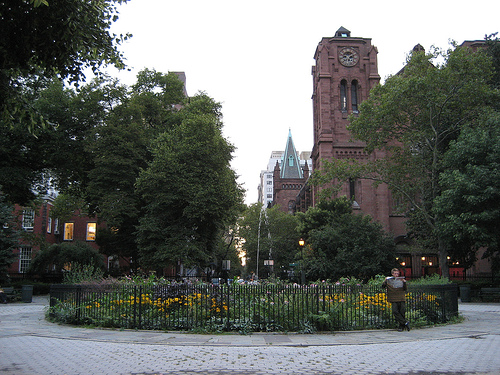Stuyvesant Square
このサイトについて
Stuyvesant Square is one of my favorite place in New York because of its history and its diversity. 1836, Peter Gerard Stuyvesant (1778–1847) – the great-great-grandson of Peter Stuyvesant – and his wife Helena Rutherfurd reserved four acres of the Stuyvesant farm and sold it for a token five dollars to the City of New York as a public park, originally to be called Holland Square, with the proviso that the City of New York build a fence around it. As time passed, however, no fence was constructed, and in 1839, Stuyvesant's family sued the City to cause it to enclose the land. Not until 1847 did the City begin to improve the park by erecting the magnificent cast-iron fence, which still stands as the second oldest in New York City. In 1850 two fountains completed the landscaping, and the park was formally opened to the public. The public space joined St. John's Square (no longer extant), the recently formed Washington Square and the private Gramercy Park as residential squares around which it was expected New York's better neighborhoods would be built.
In the early 1900s, Stuyvesant Square was among the city's most fashionable addresses. The Stuyvesant Building, at 17 Livingston Place on the eastern edge of the Square, was home to such luminaries as publisher George Putnam, Harper's Bazaar editor Elizabeth Jordan and Elizabeth Custer, the widow of General George Armstrong Custer.
Location:
コメント
コネクション
- New York
-
- Manhasset
-
- Staten Island
- Flushing
- Bronx
- Jersey City
- Brooklyn
- New York
- China
- GlasgowUnited Kingdom
- タイ
- OgdenUnited States
- San FranciscoUnited States
- NY
- Curitiba, ParanáBrazil
- atlanticUnited States
- United States
- Darmstadtドイツ
- Bayreuthドイツ
- New York, NY
- United States
- Berlinドイツ
- New YorkUnited States
- SarasotaUnited States
- San FranciscoUnited States
- United States
- United States
- Jersey CityUnited States
-
- AkronUnited States
- BaltimoreUnited States
- United States
- Genèveスイス
インパクト
まだ誰からもインパクトは報告されていません!一番目になりませんか?





 added by
added by 

